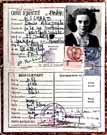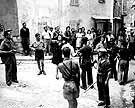
|
|
|

|

|

|

|
|
Click on an image to see a larger, more detailed picture.
|
|
|
|
|
| 1944: Desperate Acts |

|
pg. 534 |

|
|
|
|
| |
 False papers were vitally important to Jews who hid among the non-Jewish population. This French identity card, held by Lina Donoff, identified her as Denise Alice Josephine Rochard. Lina's mother made the card in order to protect her daughter from deportation. False documents of this sort were not uncommon, and often provided the protection the bearers desired. This, of course, exposes the absurdity of the Nazi insistence that physical characteristics make Jews instantly recognizable.
False papers were vitally important to Jews who hid among the non-Jewish population. This French identity card, held by Lina Donoff, identified her as Denise Alice Josephine Rochard. Lina's mother made the card in order to protect her daughter from deportation. False documents of this sort were not uncommon, and often provided the protection the bearers desired. This, of course, exposes the absurdity of the Nazi insistence that physical characteristics make Jews instantly recognizable.
Photo: United States Holocaust Memorial Museum Photo Archive
|
 One result of the liberation of France was that those who had collaborated with the Germans were arrested. Some were prosecuted while others were unceremoniously executed by the Resistance. Here, collaborators in an unidentified French town are rounded up.
One result of the liberation of France was that those who had collaborated with the Germans were arrested. Some were prosecuted while others were unceremoniously executed by the Resistance. Here, collaborators in an unidentified French town are rounded up.
Photo: Hulton Getty Images
|
 A young Frenchman found guilty of collaboration with the enemy is executed by firing squad in Grenoble. He was one of six of the town's citizens shot that day.
A young Frenchman found guilty of collaboration with the enemy is executed by firing squad in Grenoble. He was one of six of the town's citizens shot that day.
Photo: Hulton Getty Images
|
|

|

|

|

|
 June 22, 1944: The SS closes the concentration camp at Riga-Kaiserwald, Latvia.
June 22, 1944: The SS closes the concentration camp at Riga-Kaiserwald, Latvia.
|
 June 23, 1944: Operations resume at the Chelmno death camp.
June 23, 1944: Operations resume at the Chelmno death camp.
|
 June 23, 1944: The Allies learn that more than 430,000 Hungarian Jews have been deported to Auschwitz and murdered since May. There are about 300,000 Jews left alive in Hungary.
June 23, 1944: The Allies learn that more than 430,000 Hungarian Jews have been deported to Auschwitz and murdered since May. There are about 300,000 Jews left alive in Hungary.
|
 June 23, 1944: A Red Cross delegation visits the camp/ghetto at Theresienstadt, Czechoslovakia, and is apparently fooled by the camp's superficially benign atmosphere. However, the Red Cross almost simultaneously sends an official protest to Hungary about deportations of Hungarian Jews.
June 23, 1944: A Red Cross delegation visits the camp/ghetto at Theresienstadt, Czechoslovakia, and is apparently fooled by the camp's superficially benign atmosphere. However, the Red Cross almost simultaneously sends an official protest to Hungary about deportations of Hungarian Jews.
|
|
|
|
|
| 1944: Desperate Acts |

|
pg. 534 |

|
|
The Holocaust Chronicle
© 2009 Publications International, Ltd.
|
|
